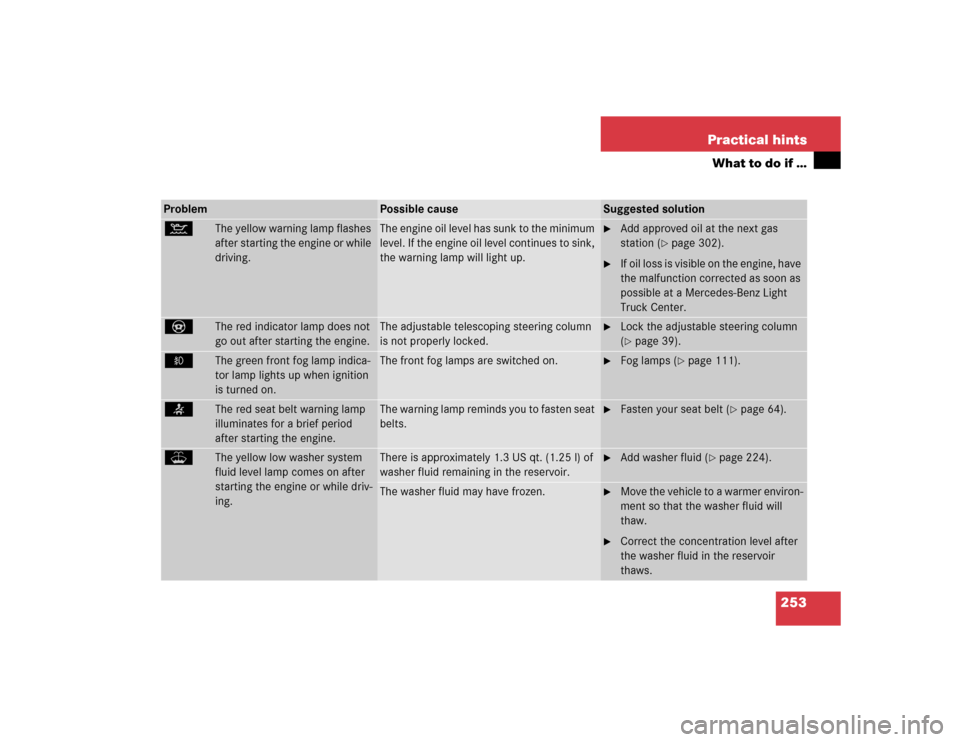Page 253 of 344

253 Practical hints
What to do if …
Problem
Possible cause
Suggested solution
:
The yellow warning lamp flashes
after starting the engine or while
driving.
The engine oil level has sunk to the minimum
level. If the engine oil level continues to sink,
the warning lamp will light up.
�
Add approved oil at the next gas
station (
�page 302).
�
If oil loss is visible on the engine, have
the malfunction corrected as soon as
possible at a Mercedes-Benz Light
Truck Center.
_
The red indicator lamp does not
go out after starting the engine.
The adjustable telescoping steering column
is not properly locked.
�
Lock the adjustable steering column
(�page 39).
‡
The green front fog lamp indica-
tor lamp lights up when ignition
is turned on.
The front fog lamps are switched on.
�
Fog lamps (
�page 111).
<
The red seat belt warning lamp
illuminates for a brief period
after starting the engine.
The warning lamp reminds you to fasten seat
belts.
�
Fasten your seat belt (
�page 64).
W
The yellow low washer system
fluid level lamp comes on after
starting the engine or while driv-
ing.
There is approximately 1.3 US qt. (1.25 l) of
washer fluid remaining in the reservoir.
�
Add washer fluid (
�page 224).
The washer fluid may have frozen.
�
Move the vehicle to a warmer environ-
ment so that the washer fluid will
thaw.
�
Correct the concentration level after
the washer fluid in the reservoir
thaws.
Page 254 of 344
254 Practical hintsWhat to do if …Problem
Possible cause
Suggested solution
#
The red charge indicator lamp
comes on when the engine is
running.
The battery is no longer charging.
Possible causes:�
alternator malfunctioning
�
broken poly-V-belt
�
Stop immediately and check the
poly-V-belt.
If it is broken
�
Do not continue to drive, before the
poly-V-belt is replaced.
Notify an authorized Mercedes-Benz
Light Truck Center.
2
The yellow brake indicator lamp
comes on during braking or after
starting the engine.
The brake pads are worn down.
�
Have the system checked at an autho-
rized Mercedes-Benz Light Truck
Center.
!Brake pad thickness must be visually
checked by a qualified technician at the
intervals specified in the Service book-
let.
Page 289 of 344
289 Technical data
Spare parts service
Warranty coverage
Identification labels
Layout of poly-V-belt drive
Engine
Rims and tires
Electrical system
Main Dimensions
Weights
Fuels, coolants, lubricants etc.
Consumer information
Page 293 of 344
293 Technical data
Layout of poly-V-belt drive
�Layout of poly-V-belt drive
1Automatic belt tensioner
2Power steering pump
3Air conditioning compressor
4Crankshaft
5Coolant pump
6Generator (alternator)
7Idler pulley
Page 294 of 344
294 Technical dataEngine
�EngineModel
ML 350 (163.157
1)
1The quoted data apply only to the standard vehicle. See an authorized Mercedes-Benz Light Truck Center for the corresponding data of all special bodies and special
equipment.
ML 500 (163.175)
1
Engine
112
113
Mode of operation
4-stroke engine, gasoline injection
4-stroke engine, gasoline injection
No. of cylinders
6
8
Bore
3.81 in (97.00 mm)
3.81 in (97.00 mm)
Stroke
3.31 in (84.00 mm)
3.31 in (84.00 mm)
Total piston displacement
227 cu in (3724 cm
3)
303 cu in (4966 cm
3)
Compression ratio
10:1
10:1
Output acc. to SAE J 1349
232 hp / 5750 rpm
(173 kW / 5750 rpm)
288 hp / 5600 rpm
(215 kW / 5600 rpm)
Maximum torque acc. to SAE J 1349
254 lb-ft / 3000-4500 rpm
(345 Nm / 3000-4500 rpm)
325lb-ft/2700rpm
(440 Nm / 2700 rpm)
Maximum engine speed
6000 rpm
6000 rpm
Firing order
1-4-3-6-2-5
1-5-4-2-6-3-7-8
Poly-V-belt
2370 mm
2370 mm
Page 312 of 344

312 Technical termsEngine oil viscosity
Measurement for the inner friction (vis-
cosity) of the oil at different tempera-
tures. The higher the temperature an
oil can tolerate without becoming thin,
or the lower the temperature it can tol-
erate without becoming viscous, the
better the viscosity.
ESP
(E
lectronic S
tability Pr
ogram)
Improves vehicle handling and direc-
tional stability.
ETD
(E
mergency T
ensioning D
evice)
Device which deploys in certain frontal
and rear collisions exceeding the sys-
tem's threshold to tighten the seat
belts.
->SRSFSS
(F
lexible S
ervice S
ystem)
Service indicator in the speedometer
display that informs the driver when
the next vehicle maintenance service is
due.
Gear range
Number of gears which are available to
the automatic transmission for shifting.
The automatic gear shifting process
can be adapted to specific operating
conditions using the gear selector
lever.
GPS
(G
lobal P
ositioning S
ystem)
Satellite-based system for relaying
geographic location information to and
from vehicles equipped with special re-
ceivers. Employs CD or DVD digital
maps for navigation.GAWR
(G
ross A
xle W
eight R
ating)
The GAWR is the maximum permissible
axle weight. The gross vehicle weight
on each axle must never exceed the
GAWR for the front and rear axle indi-
cated on the certification label located
on the driver’s door pillar.
GVW
(G
ross V
ehicle W
eight)
The GVW comprises the weight of the
vehicle including fuel, tools, spare
wheel, installed accessories, passen-
gers and cargo. The GVW must never
exceed the GVWR, indicated on the
certification label located on the driv-
er’s door pillar.
Page 314 of 344

314 Technical termsPoly-V-belt drive
Drives engine-components (alternator,
AC compressor, etc.) from the engine.
Power train
Collective term designating all compo-
nents used to generate and transmit
motive power to the drive axles, includ-
ing
�
engine
�
clutch / torque converter
�
transmission
�
transfer case
�
drive shaft
�
differential
�
axle shafts / axlesRemote Vehicle Diagnostics
Transmission of vehicle data and cur-
rent location to the Mercedes-Benz
Customer Assistance Center for sub-
scribers to Tele Aid service.
REST
(Residual engine heat utilization)
Feature that uses the engine heat
stored in the coolant to heat the vehi-
cle interior for a short time after the en-
gine has been turned off.
Restraint system
Seat belts, belt tensioner, airbags and
child seat restraint systems. As inde-
pendent systems, their protective func-
tions complement one another.RON
(R
esearch O
ctane N
umber)
The Research Octane Number for gaso-
line as determined by a standardized
method. It is an indication of a gaso-
line's ability to resist undesired detona-
tion (knocking). The average of both
the ->MON (Motor Octane Number)
and RON (Research Octane Number) is
posted at the pump, also known as
ANTI-KNOCK INDEX.
Shift lock
When the vehicle is parked, this lock
prevents the transmission selector le-
ver from being moved out of positionP
without key turned and brake pedal de-
pressed.
SRS
(S
upplemental R
estraint S
ystem)
Seat belts, emergency tensioning de-
vice and airbags. Though independent
systems, they are closely interfaced to
provide effective occupant protection.
Page 321 of 344

321 Index
Chart
Fuses 287
CHECK ENGINE malfunction indicator
lamp 248
Checking
Coolant level 215, 222
Oil level 218
Tire inflate pressure 216
Vehicle lighting 216
Checking weights
Trailer and vehicle 208
Checklist
Off-road driving 201
Returning from off-road driving 206
Child safety 67
Airbags 60
Infant and child restraint systems 64,
68
LATCH child seat mounts 72
Child safety switch see Blocking of rear
door window operation 73Cigarette lighter
Front center console 168
Cleaning
Cup holder 238
Gear selector lever 238
Hard plastic trim items 238
Headlamps 131
Headliner 238
Instrument cluster 238
Leather upholstery 239
Light alloy wheels 238
MB Tex upholstery 239
Plastic and rubber parts 239
Seat belts 238
Steering wheel 238
Windows 237
Windshield 50
Wiper blades 237
Clock 26, 118Closing
Glove box 164
Hood 218
Liftgate 92
Rear quarter windows* 147
Side windows 145
Sliding/pop-up roof* 148, 265
Closing sliding/pop-up roof*
In an emergency 265
Cockpit 22, 311
Combination switch
High beam flasher 49, 110
Turn signals 49
Windshield wipers 49
Compass 187
Calibrating 188
Setting compass zone 188
Compass zone 188
Consumer information 308
Control and operation of radio
transmitters 211